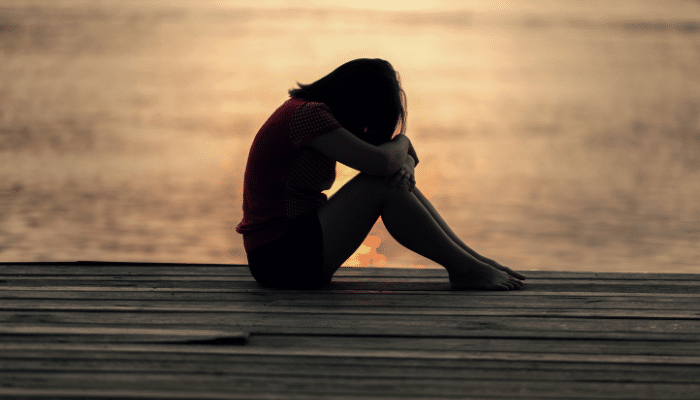“If you suddenly and unexpectedly feel joy, don’t hesitate. Give in to it.”
—Mary Oliver
When my starter marriage failed (early 20s, right out of college, three years long), I found myself in a profession I hated (public relations consultant for software companies), moving from apartment to apartment (four) in 18 months, shifting friendships with each move. For months, I felt as though I walked around with a scarlet D on my chest. D for divorce, D for despair. Life, love, work, the Big Three, all of them a terrifying mystery to me. While my peers began to settle down and think about engagements, I had already crashed and burned through a marriage, home, and career. I felt as though a tsunami had swept in and everyone else knew the secret to a great life, while somehow I had not gotten the memo. I woke every morning thinking, “I hate myself. I hate my life,” and thought that was normal.
I began to have feelings. Lots of them. I had no idea what to do with the terror or the despair. They were relentless, like hounds, and consuming.
Emotions cannot help but surge. I wish I had known that then. It is their nature and their gift. When we are crushed by life, we are often at the mercy of a heave of feelings and as they rise, they captivate us. Mistakenly, we come to believe that we are owned by them. Rage rockets us into impulsive action. Anguish devours us. We are swamped by sorrow or flooded with fear. We feel so very much and what we feel is often excruciating. Yet, also, almost unbelievably, the hopeful emotions, the possibilities of cure or reunion or resurrection, they arise, too. Hours of sorrow are followed by buoyancy or the serenity of amity, of affection. Gratitude appears for the kindness of others. Emotions dance to a rhythm we seemingly cannot control or predict. And this we must allow to the best extent we can.
We must feel our feelings. Allow them to rise and fall, to enter into our awareness and flow through us and to then dissipate in their own time. At our healthiest, this is what happens. Emotions remain in motion, moving in and moving out, shifting as the day edges forward. Allowing them to flow, we come to find the truth of our experience. Here’s Anne Lamott:
“But you can’t get to any of these truths by sitting in a field smiling beatifically, avoiding your anger and damage and grief. Your anger and damage and grief are the way to the truth. We don’t have much truth to express unless we have gone into those rooms and closets and woods and abysses that we were told not go in to. When we have gone in and looked around for a long while, just breathing and finally taking it in—then we will be able to speak in our own voice and to stay in the present moment. And that moment is home.”
We mustn’t negate that we are afraid or angry or disheartened, nor that we feel hopeful or optimistic. Instead we must allow ourselves to know what we truly feel and invite ourselves to become comfortable there, comfortable with the good, at ease with the difficult. We can only make wise choices about how to respond when we allow our authentic experience first. It would be senseless to try to be happy while we are actively terrified and insanity-making to pretend to only ever be sad or only be worried or only ever be happy. Have you met that person? The one who is always smiling and everything is fine and her shoes match her bag or his tie aligns perfectly with the oh-so-perfect cinch of his jacket every single day? Or the one who can never admit that she is content or inspired or optimistic. Frankly, it’s exhausting to be near them … almost as exhausting to be them, to force ourselves to feel what we don’t feel.
Can we lay that burden down?
As we let our feelings simply be, they catalyze the rising of other emotions, other possibilities. Sorrow, when fully experienced, often opens into sweetness or humor, anger transforms into compassion, tenderness becomes fear for the vulnerability of others, which then becomes kindness. As we allow ourselves to feel one aspect of loss, our capacity to experience the full range of emotions available to us increases. Israeli Prime Minister Golda Meir once wrote, “Those who don’t know how to weep with their whole heart don’t know how to laugh either.” And the opposite is true. Each time we make room for the fullness of our joy, our delight, we create a reservoir within that allows a greater safety in which to experience regret, torment, terror. Emotions no longer hold us captive, locking us into a too-narrow way of being. Our emotional capacity becomes wide and deep, fluid and flexible.
When that happens we can see, really see.
Register now for Authenticity: Building Capacity for a Thriving Life, with Maria Sirois.

Maria Sirois
Dr. Maria Sirois is a master teacher, facilitator, and author. She is devoted to the science of well-being and the art of crafting a life and work that embodies health, passion, and success. As a positive psychologist (PsyD) and international consultant, she focuses on the resilience of the human spirit, particularly when under chronic stress, during significant transitions, and/or feeling the shock of wholesale change. Known for her wisdom, authenticity, and rampant humor, Maria brings a depth of experience in personal and leadership development for corporate and nonprofit professionals, as well as community members and those who serve in the health and wellness arenas. For those who seek personal transformation and an increase in meaning, happiness, and health, she brings a wealth of perspective and research from decades of study in the mind/body medicine and resilience disciplines. Her first entree into the territory of wellness was as a volunteer at the then-groundbreaking Benson-Henry Mind/Body Institute in Boston, where she learned to offer mindfulness practice and stress-reduction techniques to those suffering from chronic and acute pain. Her work today integrates this perspective with the tenets of wholeness found in positive psychology. With world thought leader Tal Ben-Shahar and WBI CEO and cofounder Megan McDonough, Maria co-leads a year-long certificate program for executives, educators, entrepreneurs, counselors, and the general public. In addition, Maria is the author of two books, A Short Course in Happiness After Loss (And Other Dark, Difficult Times) and Every Day Counts (Lessons in Love, Faith and Resilience from Children Facing Illness). For more about her work, visit mariasirois.com.



Thank you, Maria, for the beautiful way you’ve expressed the vital need for allowing ourselves to experience our feelings. I wholeheartedly agree and have found my own transformation through allowing myself to really feel and observe emotions in the moment they are alive.
As an emotional intelligence coach and trainer, I strive to share this same message with my clients – and to take it deeper to also explore the underlying values and needs represented by the emotions. Such important work!